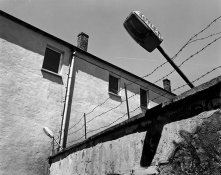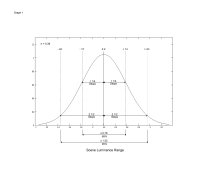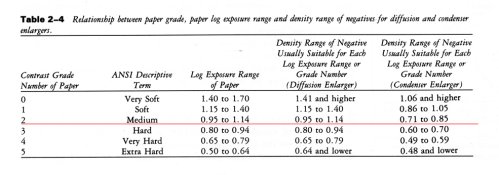David, this part of the problem. It is an unlikely scenario. It is much more probable the person has read something about EIs or "real" speeds or the Zone System or whatever, and has decided at the outset to find an EI which is better than the ISO speed. That's the legacy of the Zone System - ie the presumption, before even shooting one picture, that we should do a test which will somehow reveal a personal EI.
In reality, there is nothing really "personal" about it, and no mystery behind it. Why does everyone's "personal" Zone System EI end up the same (1/2 to 1 stop lower than ISO speed)? Because in a Zone System test you look for the speed point 2/3 stop lower than in the ISO model. That's about all there is to it from a practical testing perspective. Not only do you not need a densitometer, you don't need need a test. Just down rate the film by a stop.
Regarding manufacturers knowing or not knowing how I want to shoot, I think that is another Zone System red herring, particularly in the context of current materials. It also works under the misguided assumption regarding the level of precision we can achieve. There is nothing to be gained by calibrating an EI to 1/3 stop precision.
Your test methodology is as good as any other no-flare/low flare model (although "minimum time to max black" can be problematic), but ultimately is subject to the same shot-to-shot variables as ISO or any system. I'm not saying it is wrong and I'm not advocating against it. What Stephen is trying to get us all to understand is simply that we should be aware of what these tests are or aren't telling us.
Here's another thought. Why don't we just dispense with EIs, use the ISO speed and simply place values one Zone higher? It's all arbitrary anyway, so why not?
A thought regarding Adams (who I admire greatly): Most of his famous images are from negatives made before the Zone System, negatives he messed up on etc. Read his stuff carefully and it is mostly about latitude, and we have quite a bit more flexibility at our disposal than he did.
More questions: In the context of current long scale films and VC papers, is the Zone System still relevant? Do we have the control we think we have over our negatives? I've tried to test quite a few of these controls and the results were sobering.
Michael, I'd just like to add that sensitometry, like all science, is a diagnostic tool to examine and explain phenomena. You don't have to do sensitometric testing to use tone reproduction theory to examine a process. We know that the Zone System will produce consistently lower EIs because it has different testing parameters than the ISO method, and we can know that because we understand the process through knowledge of sensitometric principles. And we can illustrate it and communicate it to others through the language of sensitometry.
Do people generally find their EIs 2/3 (+-1/3) stop lower than the ISO rating? They do. This is a strong indication our theory is correct. Where did the theory come from? Working out the steps and figuring out the differences. ZS starts at the metered reading and stops down 4 stops. That's a difference of 1.20 log-H. No curves or densitometers used. The ISO speed point is at a fixed density of 0.10 and uses the equation of 0.80/H
m. The equation used for the metered exposure point is 8/H
g. Let's use 125 speed for example. 0.80/125 = 0.0064, 8/125 = 0.064. That's a 1.0 log-H difference or 3 1/3 stops. The difference between the resulting Zone System speeds and the ISO speeds, all things being equal, is 2/3rds of a stop. Determined through simple reasoning. Even better, this can be illustrated using pictures or curves.
Sensitometric principles can be used to evaluate what a process is actually doing or if there are potential flaws or unconsidered variables involved. We know that the rate of a falling object is 32 ft/s
2. If a dropped object takes longer than calculated then other forces must be at work, like air resistance. If somebody didn't know gravity was a constant, they could easily come to a different conclusion as to why the feather took longer to fall than the rock. Aristotle sure did.
The argument against manufacturers testing under control conditions comes from not understanding the scientific process. Lyod Jones did psychophysical testing to determine film speed, paper grades, and most of the concepts of tone reproduction like matching the scene through the negative and reproducing it on a print. You could say everything was reverse engineered. Images were shot and printed. People then judged what was good. Jones and his people then looked at the sensitometric data from the negatives and prints that produced the prints judged as having the highest quality. He then try multiple testing methods to determine which method would produce the same results from the judged prints (judged print speeds) over the widest range of film types and shooting conditions. So even though the tests are done in the lab (in order to be consistent and eliminate unwanted variables), the results are linked to usage.
As for people unhappy with the ISO speeds. The most likely explanation is from how they use their equipment or from personal taste (this includes how the print looks to them). If one test generally produces a consistent result relative to another test (in this case the ISO speed), why retest? Not happy with the results using the ISO setting, use the ISO as a base and go from there. Read the ISO speed, open up 2/3rds of a stop and Bobs your uncle. The claim that ZS testing incorporates your equipment, etc is mostly rubbish if you break it down. You'd have to a test for every lens you own, at every shutter speed, at every f/stop? There are a bunch of other variables that aren't even considered most of the time? If a person is concerned about their equipment, including meter calibration. Get it checked. Then if necessary factor in those results. If want to know the film speed, test for just the film speed.
Truthfully, I suspect the emphasis placed on the importance of ZS film speed checking is because you can't determine the film's contrast without it. Another shortcoming?
Finally, art is a combination of craft and expression. Anyone who argues differently is being disingenuous.




 .
.


